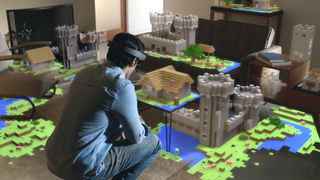Microsoft Trials New HoloLens Technologies For Construction Work

Microsoft said it's working on two new technologies--Automated Progress Monitoring and Automated Bridge Damage Detection--to make its HoloLens augmented reality (AR) headset more useful to the construction industry. The company's working on the project with the Construction Information Technology Lab at the University of Cambridge and Trimble, which released in November the first broadly available HoloLens app, SketchUp Viewer.
Not that "broadly available" means SketchUp Viewer is going to have millions of users. HoloLens developer kits only started to ship in March 2016, and they cost a whopping $3,000 a pop. Even then, it was available only to Windows Insiders in the United States and Canada. Microsoft is being cautious in its rollout of the AR (or as it calls it, mixed reality) platform--we didn't even know how it worked or what components were crammed into the HMD until August 2016.
Still, it's clear that Microsoft thinks HoloLens has potential in the construction space. SketchUp Viewer is used with Trimble's SketchUp software (who'd have thunk?) to view 3D models in AR. But that might not be enough to convince the world that HoloLens is the future, and that's where today's announcement of two new AR-focused trials comes in. Here's what Microsoft had to say about the Automated Progress Monitoring it's working on:
[It's] a way to address one of the most laborious, time consuming and error prone procedures in the industry: the demand to regularly, and manually, inspect remote structures. The process is currently conducted through visual inspections, form filling and report writing, and is made particularly painstaking by the need to extract information from different drawings and databases. The new trial revolutionises the process by presenting all physical and digital information through HoloLens, allowing inspectors to check, cross-reference and report on inspections very quickly, and collaborate with site representatives.
And here's its description of Automated Bridge Damage Detection:
Rather than sending structural engineers to each bridge as part of its inspection routine, through discoveries generated via the collaboration, high-resolution images can be taken by local teams and sent to inspection engineers. These are then automatically mapped onto 3D models of the respective bridge. Structural engineers can then review the integrity of a bridge in mixed reality using HoloLens, making recommendations for repairs or other preventative measures. This reduces costs and is more efficient, making sure bridges do not enter their ‘failure zone’, leading to major road closures and disruption.
Hard to argue with that. Nobody likes traffic jams--or the prospect of incredibly heavy bridges falling on their face--and Microsoft is positioning HoloLens as the device to make sure neither happens. Games like an experimental Pokémon Go that actually meets the standards for AR can be interesting, but given that Microsoft sells dev kits at prices far higher than top-of-the-line VR HMDs, odds are good that it's targeting businesses instead of consumers.
Stay on the Cutting Edge
Join the experts who read Tom's Hardware for the inside track on enthusiast PC tech news — and have for over 25 years. We'll send breaking news and in-depth reviews of CPUs, GPUs, AI, maker hardware and more straight to your inbox.
Check out the video below to learn more about what Microsoft, Trimble, and the University of Cambridge are working on.

Nathaniel Mott is a freelance news and features writer for Tom's Hardware US, covering breaking news, security, and the silliest aspects of the tech industry.
-
firefoxx04 "The company's working...."Reply
Who proofs this garbage?
"The company is working... " is correct. Also, please stop using contractions, Tom's. It's not proper for a company that publishes articles.
Sorry if I am being harsh but I find errors like this in a lot of articles on this site.
Most Popular

